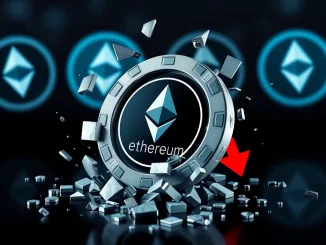
Are you holding Ethereum (ETH)? If so, you might be sitting on a digital asset that industry experts believe is dramatically undervalued. Forget the current price; leading technologists and figures in the Ethereum ecosystem are making a bold claim: ETH’s true potential is far higher than traditional financial models suggest. This perspective is gaining traction, highlighted in a new institutional report, “The Bull Case for ETH,” which suggests a staggering long-term target of $740,000 per token. This isn’t just hype; it’s based on a fundamental re-evaluation of what Ethereum is and its critical role in the burgeoning on-chain economy.
Why Experts See Ethereum as Severely Undervalued
The core argument for Ethereum’s undervalued status stems from its foundational position in the decentralized web. Unlike a typical tech stock, which is valued based on revenue or user growth, ETH serves multiple vital functions within its network and the broader crypto ecosystem. The report cited by The Block points out that Ethereum currently secures an immense $767 billion worth of assets. This isn’t just passive storage; it’s value actively locked and utilized on the network.
Think of ETH’s roles:
- Collateral: ETH is frequently used as collateral in decentralized finance (DeFi) protocols, enabling lending, borrowing, and other financial activities without intermediaries. This utility creates constant demand and locks up supply.
- Computational Fuel (Gas): Every operation on the Ethereum network, from sending tokens to executing complex smart contracts, requires gas, which is paid in ETH. This makes ETH essential for accessing and using the network’s capabilities.
- Yield-Generating Infrastructure: With the transition to Proof-of-Stake, ETH can be staked to secure the network and earn rewards. This turns ETH into a productive asset, generating yield for holders, similar to how bonds pay interest or stocks pay dividends.
These functions position ETH not just as a speculative asset but as critical infrastructure powering a new economic layer. Traditional valuation models, designed for companies or commodities, struggle to capture this multi-faceted utility and its potential network effects.
Can Legacy Models Value Digital Assets Like ETH?
Vivek Raman, co-founder of the ETH think tank Etherealize, is a strong proponent of abandoning legacy financial models when assessing digital assets. He argues that blockchain networks and their native tokens constitute a fundamentally new asset class. Trying to fit them into existing boxes like ‘currency,’ ‘commodity,’ or ‘security’ is insufficient and leads to underestimation of their true value.
Raman suggests that a more appropriate approach is to compare ETH to global reserve assets – foundational elements of the existing economy. Consider assets like:
- Oil: A fundamental energy source powering global industry and transport.
- Government Bonds: Sovereign debt representing a store of value and a basis for financial systems.
- M2 Money Supply: A broad measure of money including cash, checking deposits, and easily convertible near money, representing economic liquidity.
While seemingly disparate, these assets share the characteristic of being foundational to massive economic activity. Raman posits that ETH, as the base layer of the decentralized, on-chain economy, could eventually rival or even surpass the economic significance and valuation associated with these traditional pillars.
Ethereum’s Potential: More Transformative Than the Internet?
The comparison doesn’t stop at reserve assets. Raman draws a parallel to the internet itself, suggesting that Ethereum’s eventual adoption could have a transformative impact of similar or even greater magnitude. The internet revolutionized information sharing and communication; blockchain networks like Ethereum are poised to revolutionize value transfer, ownership, coordination, and digital interaction.
Just as early internet companies were difficult to value using pre-internet metrics, accurately valuing Ethereum requires understanding its potential to underpin a significant portion of future global economic activity. If the on-chain economy grows to even a fraction of the size of the traditional economy, the value accrued to its foundational layer, ETH, could be immense.
Understanding the Bull Case for ETH
The argument for a significantly undervalued Ethereum isn’t just theoretical. It’s based on recognizing its utility, its role in securing value, and its potential as a yield-generating asset. This perspective shifts the focus from short-term price speculation to the long-term growth and adoption of the Ethereum network as a fundamental piece of global digital infrastructure.
Actionable Insight: For investors and enthusiasts, understanding this ‘new asset class’ perspective is crucial. It suggests looking beyond traditional P/E ratios or commodity supply/demand dynamics and instead focusing on network growth, dApp adoption, total value secured, and the utility functions of ETH itself.
Conclusion: Is Ethereum’s True Value Yet to Be Unlocked?
The assertion that Ethereum is severely undervalued by industry experts challenges conventional thinking about crypto valuation. By highlighting ETH’s critical roles as collateral, computational fuel, and yield infrastructure, and by comparing it to foundational global assets rather than tech stocks, a picture emerges of a digital asset with potentially massive, untapped value. While a $740,000 price target might seem audacious today, it reflects a belief in Ethereum’s capacity to become a cornerstone of the future digital economy, potentially rivaling the transformative impact and value of the internet itself. The conversation about ETH’s true value is just beginning, and it requires a new lens to fully appreciate its potential.



